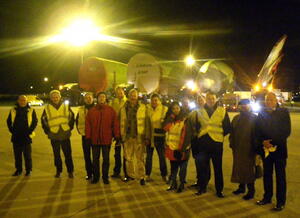Think big
On 13 and 14 January, a delegation of the ITER Transport Itinerary Coordination Group (ITICG) paid a visit to the Airbus factories in Toulouse and, later that night, witnessed the delivery of two airplane wings, a tail wing and three parts of the A380 fuselage along the convoy's last 35 kilometres from the "day" parking site at l'Isle-Jourdain to the assembly site in Toulouse.
The procedure for the assembly and delivery of the superjet's main components very much resembles that of ITER, where the big components will arrive from overseas at Berre l'Etang near Marseille and then travel along a special itinerary to Cadarache. At Airbus, major structural sections of the A380 are built in France, Germany, Spain, and the United Kingdom. Due to their size, they are delivered to the assembly hall in Toulouse, France by surface transportation.
Similar to the ITER Itinerary, roads and canals had to be widened and replaced for Airbus "convois exceptionnels," bridges were reinforced or newly built, and new barges were developed to deliver the A380 parts. It takes Airbus convoys three nights to travel the 240 kilometres between Bordeaux and Toulouse. Many spectators flank the road to see the show every time the convoys roll by; in the small village of Lévignac, convoys have to pass within centimetres of the village's homes and shops.
"The Airbus experience has already proven very useful in the preparation of the itinerary for the transport of ITER components," says Akko Maas, chair of the Coordination Group and spectator that night. "In the past we learned how to convince French administration what needs to be done; this time we learned a lot about how things are done in practice during the transport, and what they have learned from five years experience. We were very impressed by the efficiency of the operation."
After four hours, the convoy finally reached the Airbus site—allowing both drivers and spectators to return home to rest. "It was a tiring and unusual mission," Akko sums up, "but one that has greatly helped our understanding of the practical aspects of the transport of large components."
Thanks to Akko Maas for his contribution to this article.



